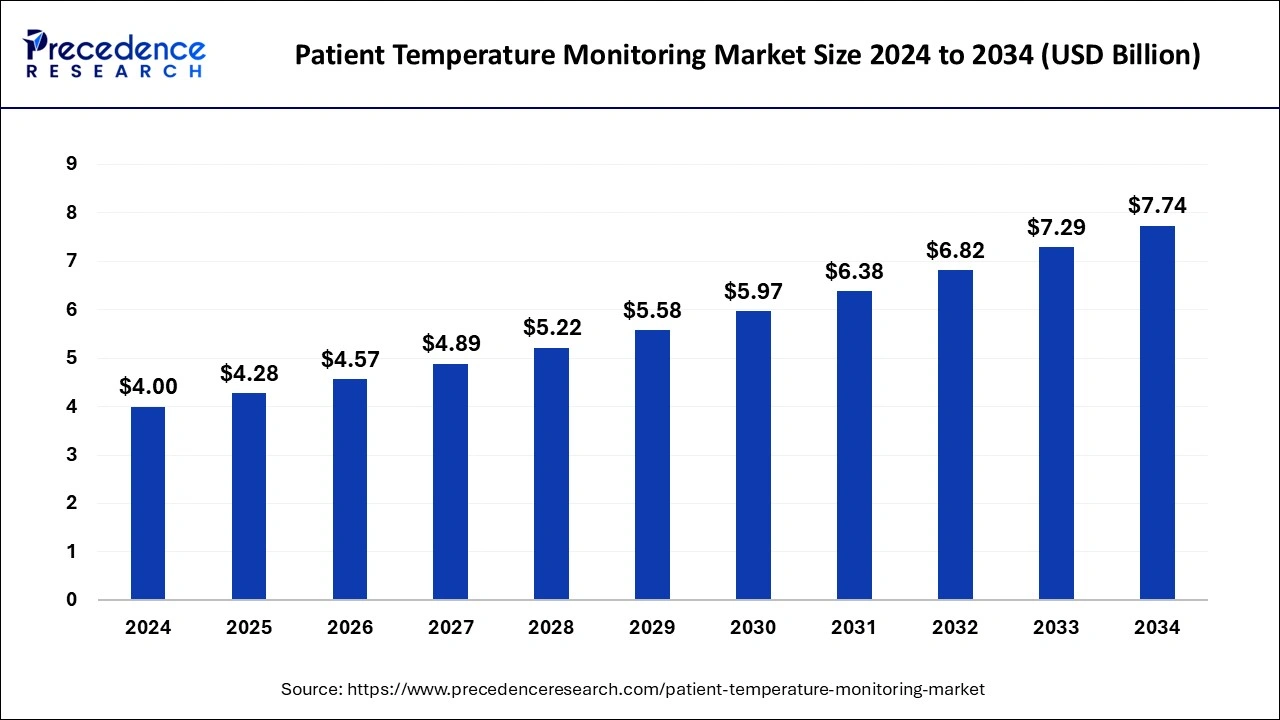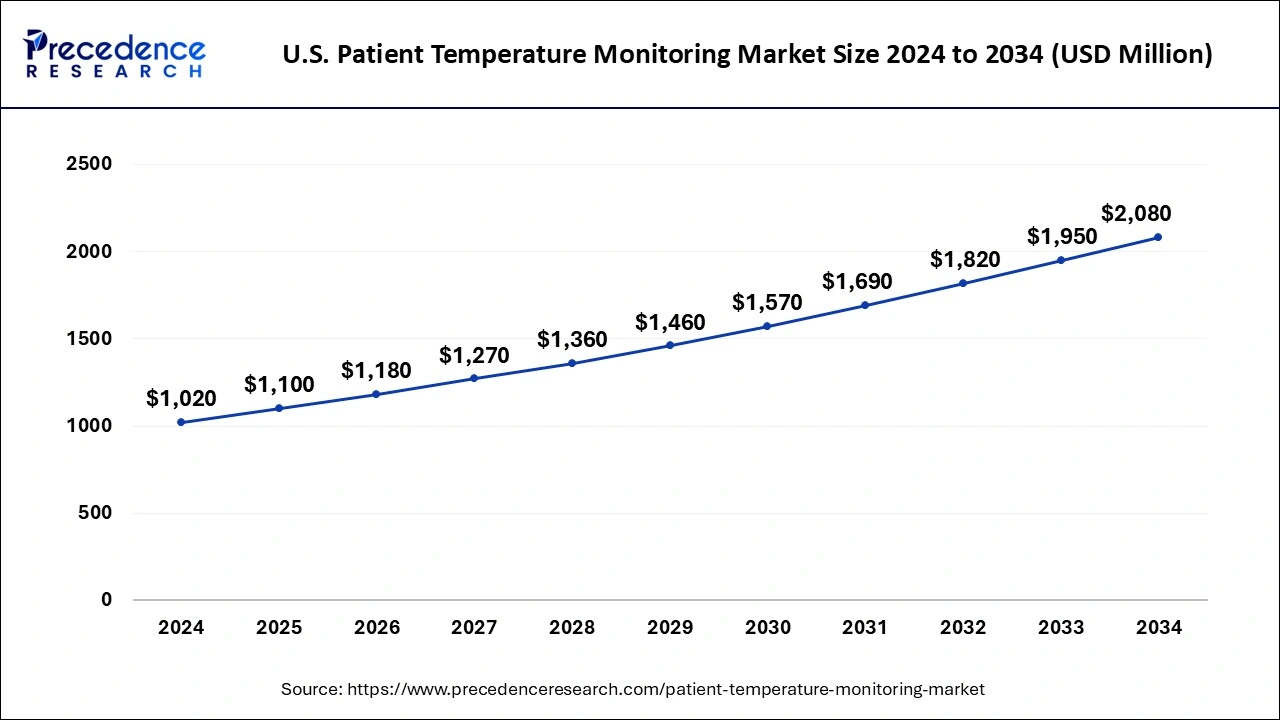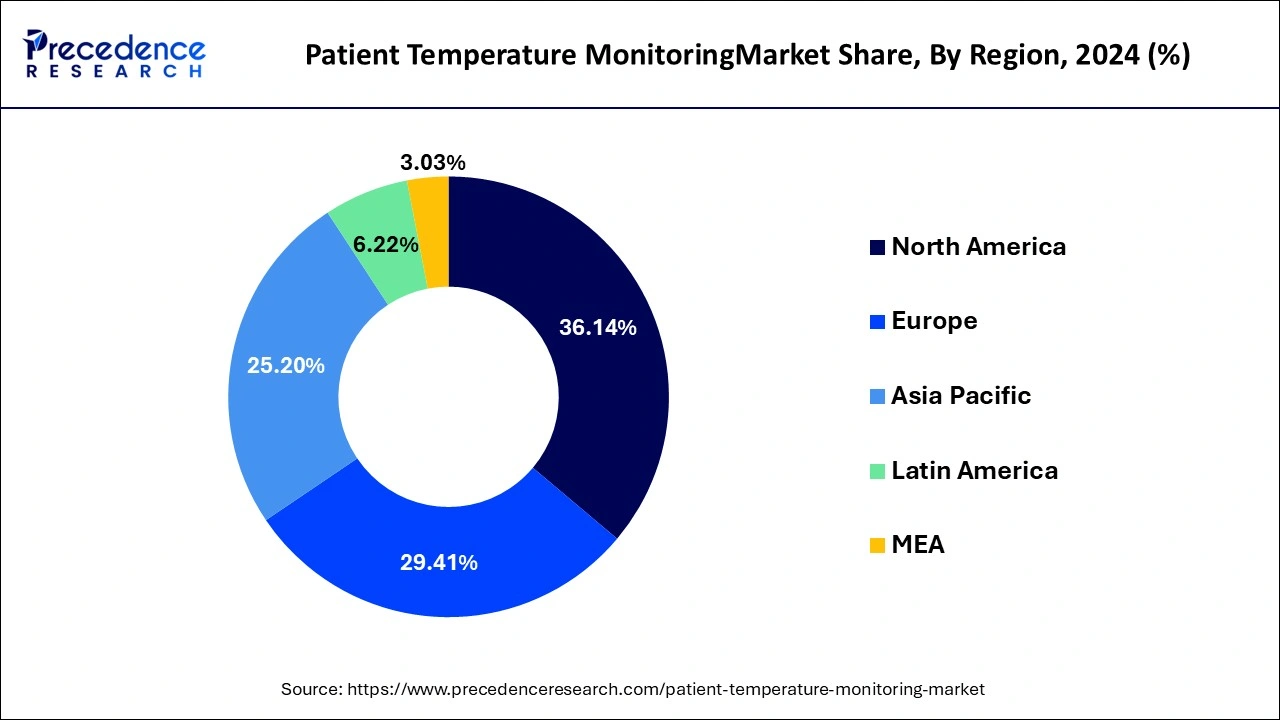January 2025
The global patient temperature monitoring market size is calculated at USD 4.28 billion in 2025 and is forecasted to reach around USD 7.74 billion by 2034, accelerating at a CAGR of 6.82% from 2025 to 2034. The North America market size surpassed USD 1.45 billion in 2024 and is expanding at a CAGR of 6.84% during the forecast period. The market sizing and forecasts are revenue-based (USD Million/Billion), with 2024 as the base year.
The global patient temperature monitoring market size accounted for USD 4.00 billion in 2024 and is expected to exceed around USD 7.74 billion by 2034, growing at a CAGR of 6.82% from 2025 to 2034.

The U.S. patient temperature monitoring market size was exhibited at USD 1,020 million in 2024 and is projected to be worth around USD 2,080 million by 2034, growing at a CAGR of 7.39% from 2025 to 2034.

The North America region's domination is due to the rising incidence of infectious diseases including COVID-19, influenza, and other illnesses, which has boosted the use of temperature monitoring systems. For instance, 3.8 million confirmed cases of COVID-19 were recorded in the United States in July 2020, according to the Centers for Disease Control and Prevention. Additionally, the existence of major businesses working in this area will increase sales of temperature monitoring systems. The market in Europe is expected to expand significantly as a result of increased financing for digital thermometer clinical studies. Due to rising public awareness of the need of temperature control during the coronavirus pandemic and the penetration of businesses to meet the market's unmet demands, the Asia Pacific market is predicted to have a higher CAGR. For instance, Secureye introduced a non-contact thermometer as part of their MediSec product line in India in June 2020.
Due to the relatively lower adoption of the devices, Latin America, the Middle East, and Africa are predicted to hold a smaller market share for temperature monitoring systems.

An essential factor in illness diagnosis is the rise in temperature, which is a frequently seen indicator during viral infection or many other serious health disorders. Increased frequency of infectious and chronic diseases and growing public awareness of the value of temperature monitoring are two factors driving the patient temperature monitoring market. In the upcoming years, it is also projected that an increase in technological and distribution collaborations would fuel market expansion.
The market's expansion is being hampered by emerging nations' high prices for sophisticated temperature monitoring equipment. The expanding healthcare sector's infrastructure and the incorporation of cutting-edge technology platforms into procedures for temperature monitoring present profitable business chances to market participants. Changes in a patient's body temperature are a result of circumstances specific to that patient's condition. To preserve its built-in defenses, the human body regulates its interior temperature. Other clinical signs such as hyperthermia or hypothermia, the presence of an infection, and the analysis of antimicrobial drugs serve to emphasize the importance of continuous temperature monitoring. These benefits are expected to speed up the use of thermometers throughout the forecast timeframe. The majority of people are quickly switching from traditional treatment to preventative care in both developed and developing nations.
Healthcare organizations and individuals all over the world are embracing the idea of preventative care and a holistic wellness strategy to address problems related to health. This state-of-the-art strategy for preventative care includes regular doctor visits, immunizations, prescription medications, and testing. The continual observation of patient temperature is one of the main elements of preventative medicine. Additionally, government representatives focus on implementing these preventative measures in order to slow or halt the spread of disease. For instance, to maintain track of these important body vital signs, the Centers for Disease Control and Prevention advise all corporate units to check the employees' body temperatures each day. It is widely anticipated that the market expansion during the forecast period would be driven by the increasing emphasis on preventative care and ongoing temperature monitoring.
The majority of people are quickly switching from traditional treatment to preventative care in both developed and developing nations. The notion of preventative care and a holistic wellness approach is being adopted by healthcare organizations and individuals worldwide to manage illnesses connected to health. This cutting-edge approach to preventative care involves scheduled medical visits, prescription drugs, vaccinations, and tests. For instance, to maintain track of these important body vital sign, the Centers for Disease Control and Prevention advise all corporate units to check the employees' body temperatures each day. It is widely anticipated that the market expansion during the forecast period would be driven by the increasing emphasis on preventative care and ongoing temperature monitoring.
Increased frequency of infectious and chronic diseases and growing public awareness of the value of temperature monitoring are two factors driving the patient temperature monitoring market. In the upcoming years, it is also projected that an increase in technological and distribution collaborations would fuel market expansion. The market's expansion is being hampered by emerging nations' high prices for sophisticated temperature monitoring equipment. The expanding healthcare sector's infrastructure and the incorporation of cutting-edge technology platforms into procedures for temperature monitoring present profitable business chances to market participants.
| Report Coverage | Details |
| Market Size in 2025 | USD 4.28 Billion |
| Market Size in 2024 | USD 4.00 Billion |
| Market Size by 2034 | USD 7.74 Billion |
| Growth Rate from 2025 to 2034 | CAGR of 6.82% |
| Largest Market | North America |
| Fastest Growing Market | Asia Pacific |
| Base Year | 2024 |
| Forecast Period | 2025 to 2034 |
| Segments Covered | Product, Type, Application, and End-User |
| Regions Covered | North America, Europe, Asia-Pacific, Latin America, and Middle East & Africa |
Increasing demand for noncontact sensor-based thermometer
Increasing population and growing prevalence of infectious diseases
The market is split into analog temperature monitoring devices and digital temperature monitoring devices based on the kind of product. In 2023, the category of digital temperature monitoring devices is in the lead. Timely product approvals are to blame for the market segment's good position. Additionally, because of social distance limits put in place to reduce infection rates, the rise in demand for gadgets during the pandemic led to the increased sales volume of digital systems.
Due to the shift in people's preference for embracing digital systems, analog temperature monitoring devices are predicted to expand more slowly than digital devices. Additionally, it is projected that the digital thermometer would continue to dominate during the projection period and post a higher CAGR. For instance, DetelPro announced the introduction of its digital thermometer in June 2020. In light of the epidemic, the corporation introduced this device to hasten the spread of digital thermometers to every family.
During the projection period, the non-invasive temperature monitoring sector is anticipated to have a profitable growth rate. This is a result of the growing collaboration between different businesses to produce these products. For instance, in May 2020, TCL and Segun Life, a well-known manufacturer of wearables and medical products, will introduce infrared digital thermometers to support the fight against COVID-19 in India.
The sector for invasive temperature monitoring is predicted to rise significantly over the course of the projection period, mostly as a result of the rising incidence of COVID-19 cases and the severe social segregation and home security measures that have resulted. As a result, the segment is projected to rise as more people embrace thermometers for prompt monitoring of body temperature.
Due to the increased usage of thermometers with a goal to maximize patient care during the COVID-19 pandemic, the healthcare facilities segment is anticipated to have a fantastic growth rate over the projection period. For instance, demand for infrared thermometers reached its high in March 2020 as a result of the abrupt onset of COVID-19 illness. Additionally, rising hospital patient visits are predicted to accelerate the segment's growth during the anticipated time period. Due to the increased use of thermometers by individuals for personal use during the pandemic, the home care environment is predicted to experience considerable growth throughout the projection period. This was supported by the government's implementation of the social estrangement standards.
By Product
By Type
By Application
By End-User
By Geography
For inquiries regarding discounts, bulk purchases, or customization requests, please contact us at sales@precedenceresearch.com
No cookie-cutter, only authentic analysis – take the 1st step to become a Precedence Research client
January 2025
March 2025
September 2024
January 2025